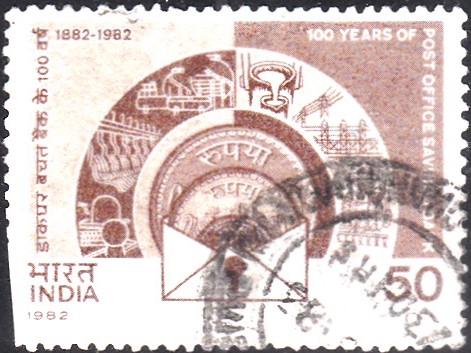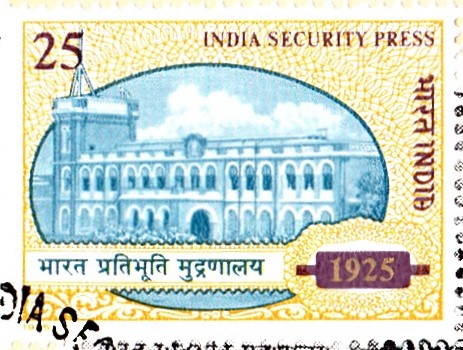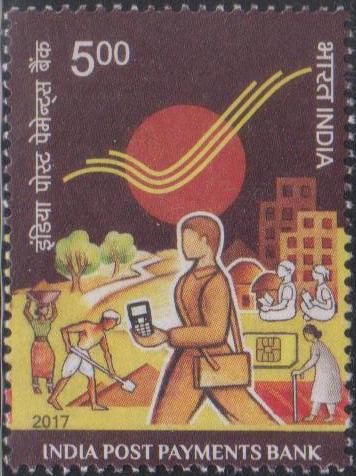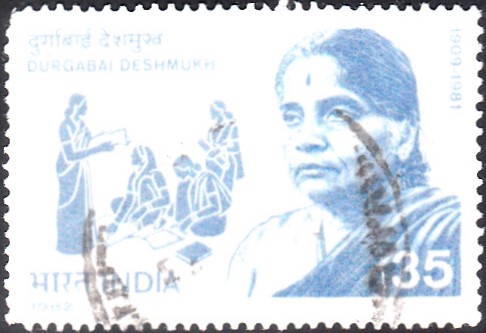
Indian Post Office Savings Bank 1982
A commemorative postage stamp on the Centenary of the Post Office Savings Bank (POSB) :
 Issued by India
Issued by India
Issued on Oct 23, 1982
Issued for : Indian Posts & Telegraphs Department is privileged to issue a commemorative stamp on 100 Years of Post Office Savings Bank.
Description of Designs : The stamp has been designed by Shashi Kant Jha. The first day cover and cancellation have been designed by Ravindera H. Zaryekar and Charanjit Lal respectively.
Type : Stamp, Postal Used
Colour : Red Brown
Denomination : 50 Paise
Overall size : 3.91 x 2.90 cms.
Printing size : 3.55 x 2.54 cms.
Perforation : 13 x 13
Paper : Unwatermarked P. G. Matt coated stamp paper
Number printed : 20,00,000
Number per issue sheet : 35
Printing process : Photogravure
Printed at : India Security Press
About :
- 1st April, 1882 was epoch making day in the history of popular banking in India. It was on that day the Post Office Savings Bank took shape in the country on the authority of the Government Savings Bank Act, 1873. Government banking had earlier existed in India but only as Government Savings Bank in the three Presidency towns, in Calcutta from 1833, in Madras from 1834 and in Bombay from 1835, and as District Savings Banks at District Headquarters from 1870. These were restricted efforts and, therefore, their impact was modest. The advent of the Post Office on the scene resulted in a big increase in the number of banks, accounts and deposits. While there were 3 Presidency banks and 180 District banks at the time, the number of Post Office banks in the very first year was 4046. In that year there were 39,000 accounts, which together had deposits of Rs. 28 lakhs. The experiment of Post Office as bank was a great success, which finally led to the merger of District Savings Banks in the Post Office Savings Bank on 1st April, 1886 and of Presidency banks on 1st October, 1896, when the Government Savings Bank became a Post Office monopoly.
- The routine growth of Post Office Savings Bank registered a big leap in 1959 when Cumulative Time Deposits were introduced for fixed terms of 5 years and 10 years, and in 1962 for the 15 year term also. The year 1970 was another land mark with the introduction of 5 year Recurring Deposits and Time Deposits of 1, 3 and 5 years. In 1973 while 5 year and 15 year Cumulative Time Deposits were discontinued, 2 year Time Deposits were introduced. The Post Office Savings Bank now runs these four schemes suited for all sections of Society.
- Cash Certificates were introduced in Post Office Savings Bank in 1917.
- With investments of Rs. 7249 crores on 1st April, 1982, in a total of approximately 530 lakh accounts besides Rs. 2078 crores in Savings Certificates, Post Office Savings Bank is among the biggest financial institutions in the country. Its uniqueness lies in the number of banks it comprises, 141,000 spread throughout the country from metropolitan cities to far flung villages. A sizeable part of investment belongs to villagers to whom 126,000 of these offices cater. Post Office Savings Bank has taken the facility and security of banking to the remote interiors and induced thrift among large mass of people. It has helped the overall development of the nation by mobilising resources on a large scale.








Oh. Its an amazing article. I have been looking around for this information. Thanks for the detailed information. It is truly helpful. Keep posting more. Thanks.
[…] Post Office Savings Bank (POSB) founded in 1873 to promote thrift and savings, much before commercial banks made their […]